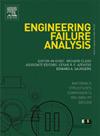多轴载荷作用下大型桁架复合弦节理的试验与数值研究
IF 5.7
2区 工程技术
Q1 ENGINEERING, MECHANICAL
引用次数: 0
摘要
桁架结构系统在大跨度屋顶和桥梁上部结构中已经变得无处不在,因为它们提供了特殊的强度重量比。本研究解决了对大型桁架节点的有限理解,其中弦深度沿跨度变化,不同的腹板形状收敛于单个节点,此处称为大型桁架复合弦(LSTCC)节点。采用可施加三维荷载矢量的多轴加载框架,对3个全尺寸LSTCC试件在最不利的服役荷载条件下进行了试验,即所有连接构件均受同步轴向压缩。研究了弦过渡细节和腹板截面(h形截面和箱形截面)的影响。试验结果表明:(1)当工字截面腹板通过翼缘传递荷载时,在1.10倍全截面屈服强度时,节点开始发生剪切主导破坏;(ii)用箱形截面代替腹板,将节理破坏延迟到全截面屈服强度的1.30倍;(3)采用更平滑的弦过渡细部,进一步将承载力提高到1.33倍全截面屈服强度,显著延缓节点板塑性。精细化的有限元模型以高保真度再现了观察到的破坏模式和应力历史,并随后用于参数化研究。数值结果表明,较小的过渡角降低了应力集中,但消除过渡段会将塑性转移到弦上,没有任何净收益。此外,弦杆上的节点区域板厚度较小,足以保证节点区域的完整性。试验与数值计算相结合,为大跨度钢桁架复杂弦节点的安全、经济设计提供了可操作的指导。本文章由计算机程序翻译,如有差异,请以英文原文为准。
Experimental and numerical investigation of large-scale truss complex chord joint under multi-axis loading
Truss structural systems have become ubiquitous in long-span roofs and bridge superstructures because they offer an exceptional strength-to-weight ratio. This study addresses the limited understanding of joints in large-scale trusses where the chord depth changes along the span and different web-member shapes converge at a single joint, referred to herein as a large-scale truss complex-chord (LSTCC) joint. Three full-scale LSTCC specimens were tested under the most adverse in-service loading condition, namely synchronous axial compression in all connected members, using a multi-axis loading frame capable of applying load vectors in three dimensions. The influences of chord-transition details and web-member cross-sections (H-section versus box-section) were investigated. The experiments revealed that (i) when an I-section web delivers load through its flanges, shear-dominated failure initiates in the joint at around 1.10 times full-section yield strength; (ii) replacing the web by a box section postpones joint failure to 1.30 times full-section yield strength; and (iii) adopting a smoother chord-transition detail further raises the capacity to 1.33 times full-section yield strength and markedly delays plasticity in the joint plates. A refined finite element model reproduced the observed failure modes and stress histories with high fidelity and was subsequently used for a parametric study. Numerical results demonstrate that gentler transition angles reduce stress concentrations, but eliminating the transition segment shifts plasticity to the chord with no net benefit. Besides, a slight thickness of joint area plates over chord members is sufficient to guarantee joint area integrity. The combined experimental and numerical evidence provides actionable guidelines for the safe and economical design of complex-chord joints in long-span steel trusses.
求助全文
通过发布文献求助,成功后即可免费获取论文全文。
去求助
来源期刊

Engineering Failure Analysis
工程技术-材料科学:表征与测试
CiteScore
7.70
自引率
20.00%
发文量
956
审稿时长
47 days
期刊介绍:
Engineering Failure Analysis publishes research papers describing the analysis of engineering failures and related studies.
Papers relating to the structure, properties and behaviour of engineering materials are encouraged, particularly those which also involve the detailed application of materials parameters to problems in engineering structures, components and design. In addition to the area of materials engineering, the interacting fields of mechanical, manufacturing, aeronautical, civil, chemical, corrosion and design engineering are considered relevant. Activity should be directed at analysing engineering failures and carrying out research to help reduce the incidences of failures and to extend the operating horizons of engineering materials.
Emphasis is placed on the mechanical properties of materials and their behaviour when influenced by structure, process and environment. Metallic, polymeric, ceramic and natural materials are all included and the application of these materials to real engineering situations should be emphasised. The use of a case-study based approach is also encouraged.
Engineering Failure Analysis provides essential reference material and critical feedback into the design process thereby contributing to the prevention of engineering failures in the future. All submissions will be subject to peer review from leading experts in the field.
 求助内容:
求助内容: 应助结果提醒方式:
应助结果提醒方式:


